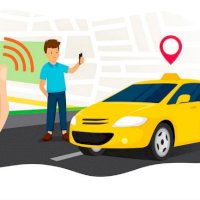The need to have a taxi app comes from the growth of e-commerce, which in turn is supported by population growth. The more people move to big cities, the greater the traffic volumes, collapsing free means of transportation.
In addition, after the pandemic, a new search for comfort was born, this has made people change their habits. Which has led to a sudden growth in on-demand services and the hyperlocal delivery app has become the current choice.
What is hyperlocal delivery?
The word hyperlocal is used to refer to all the information around a specific geographic area or area. So “hyperlocal delivery” seeks to meet the service needs of customers in a specific area quickly. Companies like Uber have partnered with restaurants and various brands to be the delivery intermediary, successfully using hyperlocal delivery.
Benefits of hyperlocal deliveries in taxi apps
One of the main benefits is that customers can track their orders in real time. Which promotes transparency of partner companies, resulting in gaining customer loyalty. Likewise, it is possible to reach a larger audience with an application. Because it allows customers to reach several locations and discover nearby stores with their deliveries.
Another advantage is that with a taxi app, companies target multiple markets or niches. Since the market is not limited to a specific industry to use hyperlocal deliveries. App technology allows businesses to leverage multiple channels, offer contactless delivery and payments, which is perfect in times of COVID-19. In conclusion, an app is convenient because it makes effective arrangements, with less effort, delimiting specific areas.
What technology is involved in the apps?
For an app to be successful and be able to fulfill hyperlocal deliveries, it must guarantee clear communication between associates, as well as their customers. Placing apps then as the backbone of an advanced business in its services. However, all of this must be based on a certain type of technology in order to function without hindrance.
Customer relationship management
CRM, as it is often called, allows companies to process the following: customer service, potential customer management, and niche automation. Since this is a software that collects all user data such as personal information, purchase history, comments and preferences. Which hyperlocal businesses use to drive sales, creating a better customer experience.
Supplier relationship management
SRM allows suppliers or sellers in a specific geographic area to upload their products and connect them with buyers. This works in the same way with suppliers as CRM does with the customer, it establishes the connection directly with them.
Navigation systems
The integration of a navigation system into a taxi app like Google Maps ensures accurate deliveries, without wasting time. GPS also allows you to target geographic areas of high demand, thus increasing sales and visibility. Not to mention how essential they are for taxi companies to reach all their destinations without memorizing all the routes in different cities.
Payment gateways
Payments that are set up digitally allow customers to carry out their transactions without cumbersome procedures. Which gives versatility so that you can choose the preferred payment method and with a considerable variety. Payment gateways such as PayPal or Binance are already quite famous, because they allow online payments in an accessible way for both the company, drivers, and customers.
Niche Versatility
When making the decision to opt for a hyperlocal delivery model, the niche and area that taxis should target must be framed. The number of services that can be provided by partnering through an app is impressive. So that this width can be visualized, we will mention the most common options.
-
Food delivery, since the hyperlocal model targets a specific geographic area, food delivery is successful. Uber is already partnering with restaurant chains to help them with food delivery. A hyperlocal model with a food delivery business is necessary to guarantee quality and freshness, with immediacy.
-
Shopping delivery, this is increasingly common since the arrival of the pandemic. People needed someone to buy the most basic things for them, so many companies adapted to offering personal shoppers. This has enabled a better customer experience and expanded business opportunities within this sector.
-
Thanks to the demand, medication delivery became a great business to partner with. Like the delivery of fuel, alcohol, pets, among other options for your company to partner with and make them profitable. The point is to look for people's needs, guaranteeing satisfaction and comfort, which is now much easier due to the hyperlocal model.
Hyperlocality as a tool
We have already seen how versatile it is to have a taxi app, even more so by implementing hyperlocal deliveries. Riding the wave of updates is knowing that you are investing in being positioned as a competitor. You can see the results in companies like Uber, which have been proof of success. Don't stop your business from growing or being more efficient, improving requires investments, but an app like this definitely pays off.






